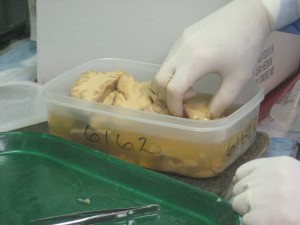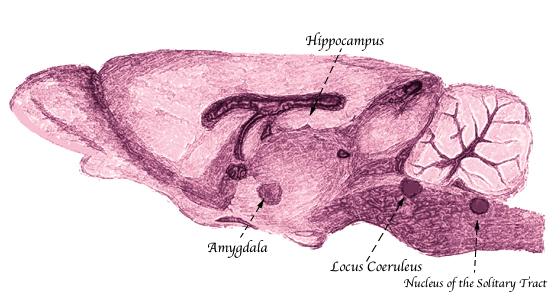By Caitlin Clancy and Becca Tarvin


The brain: its complexity, function, and anatomy have perplexed us for ages. It has remained the center of biological, philosophical, and psychological debate for as long as we first recognized it as the organ of thought and control. With our advancements in technology and consequently the functional characterization of the brain’s anatomy and chemistry, current neuroscience research is booming. As a major research university, BU is entrenched in the field, and boasts a truly amazing neuroscience program for both undergraduate and graduate students. Not only is BU one of the top schools in specific research endeavors on autism, memory systems, and addiction, but BU also supports extensive interdisciplinary education, integrating neuroscience with psychology, ecology, engineering, computer science, and much more. For example, CAS students can select a neuroscience major, biology students can specialize in neuroscience, psychology students can choose a neuroscience track, philosophy students have course offerings in the Mind, Brain, and Self, or Philosophy of Cognitive Sciences, and linguistic majors must take a courses in Language Acquisition and Cognitive Development and Language.
Memory and the Brain
Although full comprehension is certainly still in its infancy, the past twenty years has yielded great progress in understanding the neural mechanisms that underlie memory and learning. As it stands (and this is a huge oversimplification), memory can first be classified by the duration of storage1: sensory (which occurs only hundreds of milliseconds after an item/event is perceived), short-term (which permits recall of the item/event only for a few seconds or minutes without rehearsal, and has a limited capacity), and long-term (ranging anywhere from a few minutes to an entire lifetime, with greater storage allowances). Long-term memory can be further divided into declarative memory (aka explicit) and procedural (aka implicit) memory. The significant distinction between the two is that declarative memory requires some deliberate call back of the information, whereas procedural memory is tied to motor skills and learning of a task, like playing a piano piece you performed at a recital five years ago. Furthermore, declarative memory is divided between semantic memories, which are abstract facts about the world independent of any context (for instance, the state bird of Massachusetts is the black-capped chickadee), and episodic memory, which is information specific to a given context (for example, the flavor of cake at your 10th birthday party). Episodic memories often have strong emotional or personal idiosyncratic connections with the memory itself. Again, these are only some basic terms describing memory, but they provide some background on the matter.
A Glimpse into Neuroscience Research Here at BU
Excitingly, breakthrough research on memory and learning is developing right here at BU, namely in Dr. Howard Eichenbaum and Dr. Michael Hasselmo’s laboratories. Dr. Howard Eichenbaum, the Chairman Director of the Dept. of Psychology and the Director of the Center for Memory and Brain, Cognitive Neurobiology Laboratory, and the Center for Neuroscience is one of the prominent figures in

learning and memory systems research. Since it isn’t simple to study the mechanisms of memory in animals that cannot talk, the Eichenbaum lab conducts its research in part indirectly, by assessing what happens to the memory capacities of rats when their brains are damaged in certain areas. This allows researchers to describe the functions of different regions of the brain. Alternatively, electrodes can be implanted into the brains of the rats to directly track the activity of a neuron or groups of neurons. This methodology focuses more on differential brain activity during various behaviors.
A portion of Eichenbaum’s research has described the process of recognition through a neural conversation among tracks of neurons in the hippocampus (one of the primary structures implicated in memory), the outer layer of the temporal lobe, and the neocortex (the outermost layer of the cerebral hemispheres). Apparently, this type of memory involves two separable processes, familiarity and recollection, and the former can occur without the latter2 (if the “conversation” ignores the hippocampus). Eichenbaum’s research has also investigated cognitive aging, which causes similar changes to recognition as damage to the hippocampus does. Studies have revealed that there is some loss in the memory capacity of both humans and rats with age, yet familiarity tends to remain relatively intact3.

Dr. Michael Hasselmo, the director of BU’s Computational Neurophysiology Laboratory and professor at the Brain and Mind Center, Psychology Department and Neuroscience Program, researches the neurophysiological basis of memory-guided behavior in rat models. Dr. Hasselmo’s lab analyzes changes in the actual neuronal circuitry at the synapse (the junction where signals between neurons are relayed) in the hopes to elucidate a better formed circuitry diagram of memory systems. His research combines functional imaging (like fMRI scanning) to observe changes in blood flow and brain metabolism, in vivo electrode recording arrays to investigate the excitability of whole neuronal populations in an awake, behaving animal, and in vitro (that is, out of living organism and in a controlled environment) studies of removed rat tissue to inspect the individual cells and circuitry. Moreover, Dr. Hasselmo uses computational modeling to further analyze the data acquired from these various techniques and to functionally describe the systems under study.
Recently, Dr. Hasselmo’s work has concentrated on determining the purpose of cortical theta rhythms4,5: low frequency (4–7 Hz) oscillatory rhythms observed in EEGs (“Electroencephalography”, an electrode recording technique that tracks the electrical activity of excited neurons). In humans, the absolute role of theta oscillations in the hippocampus and cortices remains elusive, however in rat models they are commonly seen in the hippocampal and entorhinal cortex during learning and memory retrieval and spacial mapping tasks6. Dr. Hasselmo’s lab looks to see and model the behavioral outcomes of neuromodulation on these theta rhythms.
Research that occurs in labs such as those of Eichenbaum and Hasselmo elucidates small portions of the brain’s intricacies, year by year. The future looks promising for a greater understanding of human neurobiology. As technology continues to advance, it is very likely that we will witness huge leaps in understanding the science of memory and learning, among many other neurobiological phenomena. Whether it comes on the level of whole systems or single cell types, each finding brings new insight on how to treat a variety of diseases and disorders, from Alzheimer’s disease to Zellweger syndrome, as well as new understanding of the normal processes that underlie the extraordinary complexity of behavior and higher-order thought of which humans are capable.
_____________________________________________________
Special thanks to Sarah Head and Shiela Kern from the Blatt Laboratory for providing their photos!
References
- Purves et al. (2008). Neuroscience (4th edition). Sunderland: Sinauer Associates.
- Fortin, N.J., S.P. Wright, and H. Eichenbaum. (2004). Recollection-like memory retrieval in rats is dependent on hippocampus. Nature 431: 188-191.
- Robitsek, R.J., N.J. Fortin, M.T. Koh, M. Gallagher and H. Eichenbaum. (2008). Cognitive aging: A common decline of episodic recollection and spatial memory in rats. Journal of Neuroscience 28: 8945-8954.
- Hasselmo, ME; Eichenbaum H (2005). “Hippocampal mechanisms for the context-dependent retrieval of episodes”. Neural Networks 18 (9): 1172–90.
- Hyman, JM; Wyble BP, Goyal V, Rossi CA, Hasselmo ME (2003). “Stimulation in hippocampal region CA1 in behaving rats yields LTP when delivered to the peak of theta and LTD when delivered to the trough”. J Neurosci 23 (37): 11725–31.
- Cantero JL, Atienza M, Stickgold R, Kahana MJ, Madsen JR, Kocsis B (2003). “Sleep-dependent theta oscillations in the human hippocampus and neocortex”. J Neurosci 23 (34): 10897–903.

